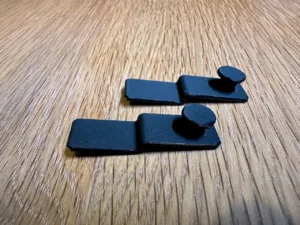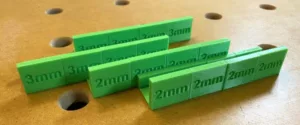There are a lot of lists and videos on YouTube about essential tools you need when you’re a beginner woodworker or getting into DIY projects. Some are the infamous “Ultimate Guides” and others are “the only five tools you need” in order to build something. All of these are great and they boil down to pretty much the same set of tools.
They all go a little something like this.
Circular Saw
This is the cheapest and simplest option for breaking down long pieces and sheet goods. Sheet goods is a term to describe large pieces of plywood. A decent circular saw can be purchased for around $150.
With a circular saw, you can cross-cut, rip-cut, plunge-cut, and create cuts for a number of different joints. Most circular saws are battery-powered these days which adds more versatility to the tool. Instead of maneuvering a large piece of wood to a tool, you can carry a lightweight tool to the wood.
It’s one of the most versatile tools in a woodworkers tool kit so it makes sense everyone puts it on their list of essential tools for beginner woodworkers and DIYers.
The expensive alternative for this is a table saw. A cheaper and more labor-intensive alternative would be a hand saw.
Drill and Driver/Impact Drill
If you’re cutting wood into smaller pieces you need a way to connect those pieces in their new configuration. The most common way is by using screws. A drill and driver set will enable you to create countersunk holes so your screws can sit flush with the wood and prevent splitting.
Well, I suppose you could get away with using a screwdriver and building up those forearm muscles, but a power drill is much more efficient. Add a set of drill bits, a countersink bit, and various bits for different screw types and you’re set.
Unless you decide to never use screws or make holes in your pieces, every woodworker needs some type of drill.
Jigsaw
Sometimes circular or curved cuts are necessary for what you want to build. In cases like this, a circular saw isn’t very well suited for the job. Enter the jigsaw.
A jigsaw has a smaller and more flexible blade than a circular saw which helps to make round and curved cuts. It can also get into some tighter spots than a circular saw due to its slightly smaller footprint.
There are multiple types of blades for jigsaws as well and it’s very easy to change them. Different blades can be used to make rough cuts, fine cuts, or even to cut through metal.
The jigsaw is basically a small, portable bandsaw.
Handheld Sander
Once you’ve built a thing you’ll want it to look and feel nice. Slivers are a bad time for everyone. That’s where sanding comes in. The cheapest method is hand sanding, which can be very laborious and gets old quickly. To make the job easier, get yourself an orbital sander.
Buying a battery-powered orbital or random orbit sander will save you loads of time during the sanding stage of your projects. They allow you to cover more surface area and remove more material faster than if you were to do the job by hand. Not to mention, orbit sanders come with at least a rudimentary dust collection system to help prevent inhaling tiny dust particles.
There are tons of options for sandpaper you can use in a range of different grits. In 95% of cases, any brand of sandpaper will work with any brand of sander. The only tradeoff is around how well it works with that particular sander’s dust collection; in other words, are the holes in the sandpaper in the same spot as the holes in the sander?
The upgrade options for sanders are really more expensive handheld sanders and drum sanders.
Router
A router is another super versatile tool most experienced craftspeople recommend for beginner woodworkers. It can be used to make edge profiles, dados, rabbets (or rebates if you’re speaking the queen’s English), joinery, and copy templates.
There are a couple of different kinds of routers: fixed and plunge routers. Fixed routers allow a certain degree of adjustability regarding how deep they can cut but are called fixed routers for a reason. They are sometimes called trim routers as well. Fixed or trim routers are perfect for edge profiles and templating.
Plunge routers are a little more flexible as they can have different depths set for consistent and repeatable results. Changing between the depth stops is quick and doesn’t require any tools. Plunge routers are perfect for dados and grooves.
You can use hand tools to create the multitude of joints woodworkers use, and many do, but they require more skill, time, and patience. If you’re still learning to build projects with wood using a router would give you consistent results faster for joints like dados, mortise & tenon, half lap, and many other joinery types.
More experienced woodworkers usually end up owning several routers. They usually keep one or more handheld/trim ones, another for a router table, and if they have a CNC machine it often uses a router (also called a spindle) as the cutter.
Cost Of Entry
One of the biggest factors in most “essential”, “ultimate” or “best” tool lists for beginner woodworkers is the cost. Let’s face it, woodworking is an expensive hobby to get into.
That is why most lists will usually recommend the following brands:
- Dewalt
- Kobalt
- Ryobi
- Rigid
All of them are available at big box stores (shorthand for Lowe’s, Home Depot, and other major national chains) and, depending on the tool, are around the $100-$150 mark or less (excluding batteries, of course). Sure makes it easy to start an expensive hobby when the initial costs aren’t actually too expensive.
Heck, a decent-sized project for the home will cost you more in materials than tools if all you need is a saw, a drill, and a straight edge.
The lower the entry cost the easier it is for more people to get into and start enjoying woodworking.
A common thought is once someone has gained some confidence and decided to continue with this hobby they’ll get better at using the tools. At that point, if new woodworkers feel that they need better tools or more reliable tools they now have the knowledge to decide which of those tools they’d like to upgrade.
My opinion on the matter may be considered a little controversial though. Why should you spend money on a cheaper tool only to end up spending even more money on a more expensive tool later on? There’s a saying I tend to go by “buy once, cry once.” I feel like that applies (or should apply) to most hobbies.
The Case for Expensive Tools
Here’s a scenario for you. Becky decides she wants to learn how to DIY her own furniture or fix up her house without having to pay a contractor. She spends some time searching the internet and YouTube for DIY videos and what tools she should get to start with. After reading a few of these lists she crabs some of the low-cost brand tools I mentioned earlier. Becky is ready to go.
Sometimes these tools are low-cost because their quality control isn’t the greatest. Their tolerances may not be as tight as the more expensive tools out there. Becky doesn’t know this though, because nobody has said so in their articles or videos.
As she’s building her thing it ends up being out of square, there are gaps in places there shouldn’t be, and cut lines aren’t straight. To some people that may not be a big deal. They’ll still think, “I made this thing!” And they’ll be happy with it. Becky isn’t though. Now she’s discouraged and thinks she can’t hack it. That’s a loss to the community as a whole.
Let’s flip the scenario. Becky knows this is something she wants to do, not a one-time thing. She searches for tool lists but finds links for the best tools in each category. These tools are built with very high standards and a lot of them come tuned right from the manufacturer.
Her project comes out square because the saw cut true and straight. There are no gaps because of the tight tolerances in her straight edges, measuring tools, and squares. Becky is elated that she was able to do so well with so little experience. She’s hooked. She’s in it for the long haul. Now she’s making quality furniture and her house looks like a professional made the changes she wanted.
Quality Options
Going back to “buy once, cry once.” The idea is that if you buy a more expensive, higher quality tool or piece of equipment you won’t have to spend more money on that equipment. If you decide to get a cheaper part it has a higher tendency to break, requiring you to buy that part multiple times.
In the end, you spend more on the cheaper, lower-quality equipment than you would have if you bought the higher-quality piece the first time.
The easiest way to apply this type of thinking for the category of tools required to start woodworking is by getting into the reviews and “best of” lists. Don’t get lost in the weeds wondering how to get started for the lowest cost, look for the best tool you can afford in each tool category; saw, drill, driver/impact, sander, and router.
Here are a few ideas on some upgrades you could make.
Track Saw
Instead of buying a circular saw, go with a track saw. What’s the difference? Track saws, as the name implies, are built to easily perform plunge cuts and attach to an aluminum track system. Why does that matter?
Using a track allows you to make straighter and more repeatable cuts, and increases the accuracy of your cuts.
A few upgrade options:
If you have the money, you could even look into getting the Kreg Adaptive Cutting System (add the table top and you’re really in business). This is an awesome way to level up your work from the beginning.
Drill and Driver
While a drill press might be considered a good upgrade pick for a drill, it isn’t. A drill is one of the most used tools in a woodworker’s arsenal and it needs to be portable and easily accessible. There can be some interesting angles you need to get at as well.
For this reason, I don’t consider a drill press a replacement for a handheld drill; it’s more of a supplemental tool used for repeatable drilling.
What you can upgrade is the brand of drill and driver you’re getting. “Better brand” is subjective though, as this video from RR Buildings points out. After using several impact drills/drivers the reason he likes using a Festool more than any other brand is ergonomics.
Decide for yourself what is most important and get the best drill and driver set you can afford which meets those criteria.
Bandsaw
There’s not a lot of crazy innovation in the jigsaw market as far as I can tell. Like the drill and driver section, this would be deciding to purchase a more expensive brand with better reviews. Something like a Festool or Triton. Check out the reviews and buy the best one you can afford.
That said, if you want to go all out you could buy a decent-sized bandsaw. Buying a bandsaw would allow you to re-saw thicker pieces of lumber as well as almost all the other duties a jigsaw can perform.
The big trade-off here is portability. You can’t take a bandsaw inside to cut a small hole in a wall or cabinet to pass cables through.
Drum Sander
Sanding takes up a large portion of woodworking. One way to be more efficient at it is to get a drum sander. Instead of manually going over each piece all you need to do is put it on the feeder belt and let the machine do the work. It’s a great way to get consistent sanding across the whole piece.
Drum sanders can also be used as thickness planers. Most thickness planers with blades will only go to a certain thickness. If you want strips of wood for veneers or edge banding they need to be thinner than the smallest settings on thickness planers with blades. A drum sander will allow you to go beyond that, or I should say thinner than that.
This wouldn’t be an either-or upgrade though. A drum sander is great on flat pieces of wood but it can’t get into the nooks and crannies of more detailed work. It also can’t handle curved edges; for that, you’d want to look into spindle sanders like this one from Rigid.
Router
To upgrade your router, look for the best model you can afford. If you stick with woodworking you’ll end up owning multiple routers. Some production-level woodworkers own enough routers to make them all single-use, meaning each router only ever has one bit installed and it’s rarely if ever changed.
One way to upgrade your router besides buying a more expensive model is by building or buying a router table for it. Several companies have options for this like Woodpeckers, Rockler, Kreg, and SawStop. Many giants in the field on YouTube also have plans available for pretty cheap ($5-$20) if you want to go the DIY way.
A Quick Word About Batteries
Some people like to preach you should stick to one ecosystem, especially when you end up owning several cordless tools. The idea is that all the tools will use the same battery and you’d always have a charged battery somewhere you can use.
I’ll admit, this was a goal of mine early on. Nothing quite like seeing a row of similarly colored power tools lined up in your shop (or garage). Being able to take a battery out of my circular saw when it’s not being used to power the impact driver because it ran out of juice is nice. Honestly, though, I didn’t find myself needing to do it all that often. I think it happened maybe once.
If you’re not doing this for a living, working in a shop using power tools eight hours a day five or more days a week, I don’t think it’s necessary to stick to a single tool manufacturer. Especially considering the company making the best drill for you may not make the best circular saw or router.
Choosing one brand for all tools over another means limiting yourself to better options for the sake of battery consistency.
Instead, treat each tool as its own purchase. Buy the tool you want and don’t worry if the color scheme on your tool wall doesn’t match.



